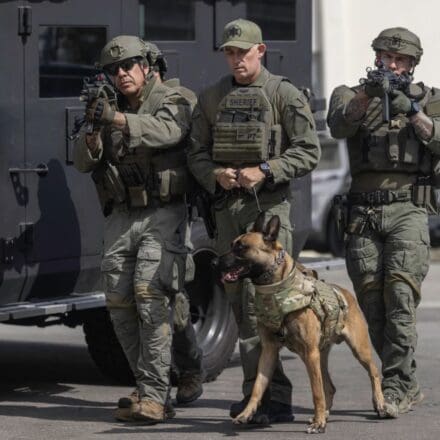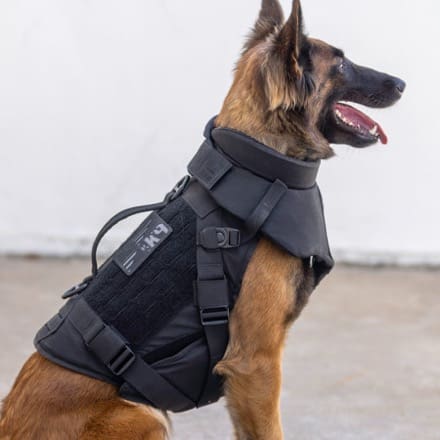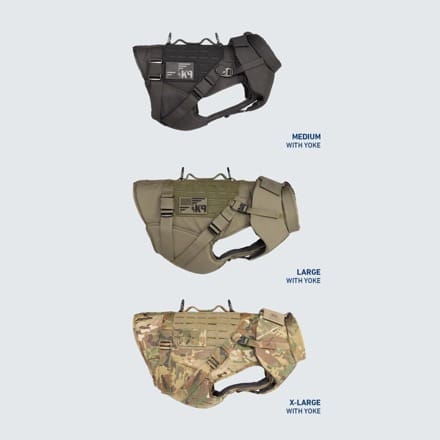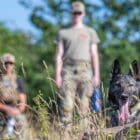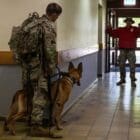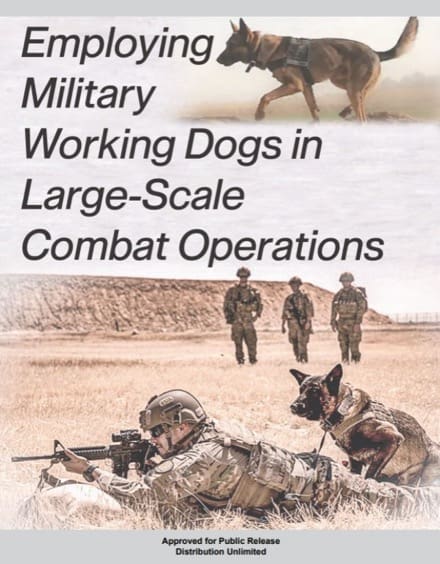
SECTION 1
Introduction
“As they approached a grass-covered hut, a machine gun opened fire. The hut was, in fact, a camouflaged bunker. Chips (military working dog [MWD]) quickly escaped Rowell’s (handler) control and made a beeline for the bunker. Within seconds, the machine gun fell silent and an Italian soldier tumbled out with Chips chomping at his throat and arms. In short order, three others exited the bunker with arms raised. Chips was lightly wounded in the incident, suffering powder burns and several cuts.”
—Seth Paltzer, THE DOGS OF WAR: THE U.S. ARMY’S USE OF CANINES IN WWII[1]
From 13 to 18 May 2024, an analyst from CALL’s Corps and Division Branch (CDB) attended the 2024 U.S. Army Military Working Dog Leadership and Training Symposium. The analyst observed military initiatives for MWD support to large-scale combat operations (LSCO) at the Alpena Combat Readiness Training Center in Alpena, MI.
The symposium demonstrated the value MWDs contribute during LSCO, especially by providing Soldiers stand-off during detection and clearing tasks. Also, of note, many MWD programs especially, those in which MWDs perform tasks untethered to the handler, require long-term investment to train and groom MWDs to work in challenging operational environments.
During the symposium, MWDs demonstrated their capability sets, which are unique from any other instrument of war, through a broad range of scenario-based training events, such as search, tracking, detection, and bite techniques. The analyst also interviewed MWD experts from U.S. and allied partners to identify lessons learned from ongoing conflicts and gaps that exist within the U.S. Army MWD program in the context of LSCO.
SECTION 2
Key Symposium Takeaways
Canines have been useful to military organizations since their domestication. Few, if any, instruments of war have the successful track record and longevity of MWDs. They remain effective in a variety of environments, including dense vegetation, subterranean complexes, and trench networks. Even in the current operational environment, there are many situations in which MWDs outperform drones and conventional equipment. Unlike machines, MWDs make decisions, use intuition, and think outside of the realm of algorithmic predictions. This is a unique aspect to their employment in detection, search, attack, and reconnaissance roles. See figures 1, 2, and 3.

Figure 1. An MWD negotiates a tunnel at Kunsan Air Base, Republic of Korea.[2]
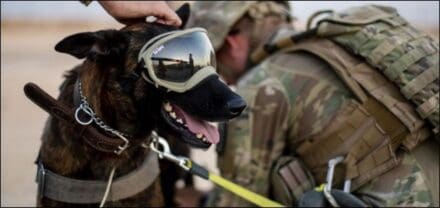
Figure 2. An Army MWD receives its protective equipment before training at Al Asad Airbase, Iraq.[3]

Figure 3. An MWD is zip-lined in rolling jungle terrain with the handler in tow.[4]
The U.S. Army has adapted MWDs for the challenging environments of each conflict it has fought in, ranging from LSCO in WWII to counterinsurgency in the Global War on Terrorism. U.S. Army MWDs must adapt for 21st-Century LSCO. This will require experimentation, investment, and training for MWDs to aid U.S. Soldiers in their fight against a peer adversary in challenging environments.
SECTION 3
Ongoing Conflict Observations
Israel-Hamas Conflict. The Israel Defense Forces (IDF) have employed MWDs at a large scale since their counterattack against Hamas and invasion of Gazan territories in 2023. The IDF MWD attrition rate has averaged several dozen per week in their employment roles of detection and assault. This has led to significant IDF investment in MWDs to sustain such attrition.[5] Current IDF replacement rates will likely create shortages in the long term. The U.S. acquires MWDs from many of the same suppliers as the IDF, Chinese, British, and others while producing few domestically. The rate of procurement and attrition of MWDs by the IDF is likely going to impact the world market and the U.S. Army’s ability to procure MWDs.[6]
The IDF have primarily employed MWDs to clear the pervasive subterranean environments in Gaza while limiting risk to their Soldiers. MWDs require familiarization with subterranean environments from a young age to be effective in those conditions. Changes in air flow, sound echoes, temperatures, confined spaces, and low light reduce MWD detection and cognition abilities without familiarization.
Russia-Ukraine Conflict.[7] Since Russia invaded Ukraine in 2022, the Armed Forces of Ukraine (AFU) have used MWDs in many situations. MWDs have been used in rear areas and the close fight to achieve effects that cannot be accomplished by drones or other equipment. The AFU primarily employs their MWDs in unexploded explosive ordnance (UXO) detection roles while maintaining stand-off distance with a handler.
Since February 2022, the AFU has detected vast numbers of UXO using MWDs in rubbled urban environments and captured trenches.[8] Metal pollution from shrapnel and other debris have required them to use MWDs in addition to standard detection equipment. MWDs are more effective than detection equipment because of high metal pollution from shrapnel. The U.S. Army can expect similar mine-clearing requirements during LSCO.
Russian tactics, techniques, and procedures (TTPs) have evolved to rigging positions with improvised explosive devices (IEDs) and booby traps before abandoning them to inflict casualties on the pursuing Ukrainian forces. MWD capability has enabled the AFU to clear these positions rapidly and to occupy them to consolidate territorial gains while preserving human life.
SECTION 4
U.S. Army Military Working Dog Gaps
Combat Training Center Involvement. The U.S. Army is currently transforming into an organization focused on fighting in large-scale conflicts against peer and near-peer adversaries. The U.S. Army uses combat training centers (CTCs) as venues for experimentation and adaptation during the shift away from counterinsurgency-focused warfighting. Two of the seven key tasks assigned to the CTC Program in Army Regulation (AR) 350-50, Combat Training Center Program, 2 May 2018, are to —
- Provide a data source for lessons learned to improve doctrine, organization, training, materiel, leadership and education, personnel, facilities, and policy (DOTMLPF-P) in preparation for unified land operations.
- Embed the most recent TTPs from current operations in theater to better prepare follow-on units.[9]
MWDs have had minimal involvement at the CTCs since 2022. The National Training Center (NTC) at Fort Irwin, CA, is the only CTC that has resident MWD handlers (military occupational specialty [MOS] 31K) assigned as observer coach/trainers (OC/Ts) and has only hosted three MWDs since 2022.[10] This has created several shortfalls. Current doctrine does not address the role of MWDs in LSCO.[11] Maneuver commanders are unfamiliar with their doctrinal employment. These two impacts have created integration gaps for MWDs in LSCO-focused training and operations.[12]
CTCs provide a realistic training environment to observe MWD’s integration into unit operations. To generate lessons for LSCO, MWD participation at the CTCs should increase. This can be accomplished by adding MWD capabilities to the CTC troop lists outlined in U.S. Army Forces Command (FORSCOM) Regulation 350-50-1, Training at the National Training Center, 29 October 2018.
“Off-Leash” Capability. A patrol explosive detector dog-enhanced (PEDD-E) is an MWD trained to operate off leash. The PEDD-E enables the handler to employ MWDs in the roles of detection, attack, and reconnaissance while maintaining distance from the search area. The value of this during LSCO when operating in unknown environments cannot be overstated for the preservation of human life while enabling maneuver.
The U.S. Army maintains additional MWD capabilities that have retained their funding. These capabilities each require the handler to employ MWDs “on leash.” This reduces MWD agility, flexibility, and the ability to preserve human life. The on-leash capability is not recommended for LSCO.
Scenarios where MWD capability is most valued during LSCO are near the forward line of own troops (FLOT). The off-leash PEDD-Es, when employed in environments such as rubbled urban structures, subterranean networks, and trench clearing, can identify and neutralize threats, inform U.S. personnel, and preserve human life.
U.S. Army Training and Doctrine Command (TRADOC) stopped funding the PEDD-E course in fiscal year 2024. Consequently, the Army will exhaust its inventory of off-leash trained MWDs between 2030 and 2032. The re-establishment of a PEDD-E training program and procurement of MWDs, training, and certification to restore this capability would likely range between two and three years.
SECTION 5
Conclusion
MWDs have consistently proven their value over centuries of evolving warfare. The United States and others have continuously adapted the employment tactics and training methodologies to tailor MWDs to the current operational environment. Drones and other detection and sensing technologies will continue to evolve. The ability to counteract and deny these technologies will also evolve. MWDs can operate in technologically nonpermissive environments and outperform technology in many situations.
AFU and IDF experiences demonstrate the value off-leash MWDs provide to maneuver forces during LSCO. The U.S. Army should consider these recent experiences and leverage resources like the CTCs to refine TTPs being employed by AFU and IDF partners. The U.S. Army may also want to reconsider funding levels for the program, considering the lead times required to train off- leash MWDs.
SECTION 6
Endnotes
1. Paltzer, Seth, THE DOGS OF WAR: THE U.S. ARMY’S USE OF CANINES IN WWII, The Army Historical Foundation, https://armyhistory.org/the-dogs-of-war-the-u-s-armys-use-of-canines-in-wwii/.
2. Photo by SRA Ashley L. Gardner, U.S. Air Force, www.pacaf.af.mil/News/Article-Display/Article/706335/ mwd-train-to-keep-paws-on-the-ground.
3. Photo by SPC Derek Mustard, Combined Joint Task Force – Operation Inherent Resolve, www.dvidshub.net/image/6231629/military-working-dogs-wear-protective-equipment-live-fire-exercise.
4. Photo provided by the U.S. Army MWD Program, www.facebook.com/photo/.
5. In-person interview with an operations officer from the 1st Military Working Dog Regiment, British Army, 16 May 2024.
6. Ibid.
7. Ibid.
8. Ibid.
9. AR 350-50, Combat Training Center Program, 2 May 2018, page 2, armypubs.army.mil/epubs/DR_pubs/DR_a/pdf/web/ARN8650_AR350_50_Final.pdf.
10. SFC Phillip Ventimiglia, NTC 31K OC/T, in-person interview, 14 May 2024.
11. Army Techniques Publication (ATP) 3-39.34, Military Working Dogs, 19 May 2022, armypubs.army.mil/epubs/DR_pubs/DR_d/ARN35094-ATP_3-39.34-000-WEB-1. (common access card [CAC] required)
12. SFC Phillip Ventimiglia, NTC 31K OC/T, in-person interview, 14 May 2024.
By CPT Alexander Spook, CPT James Campbell, Center for Army Lessons Learned


